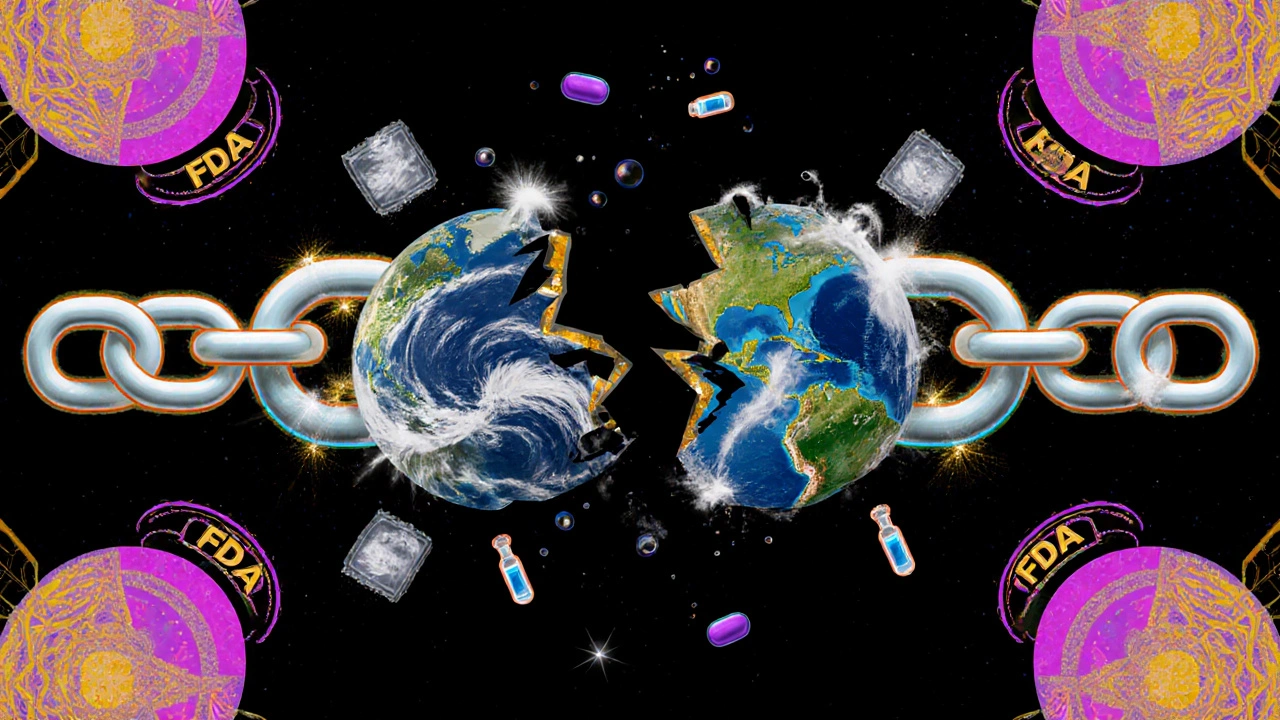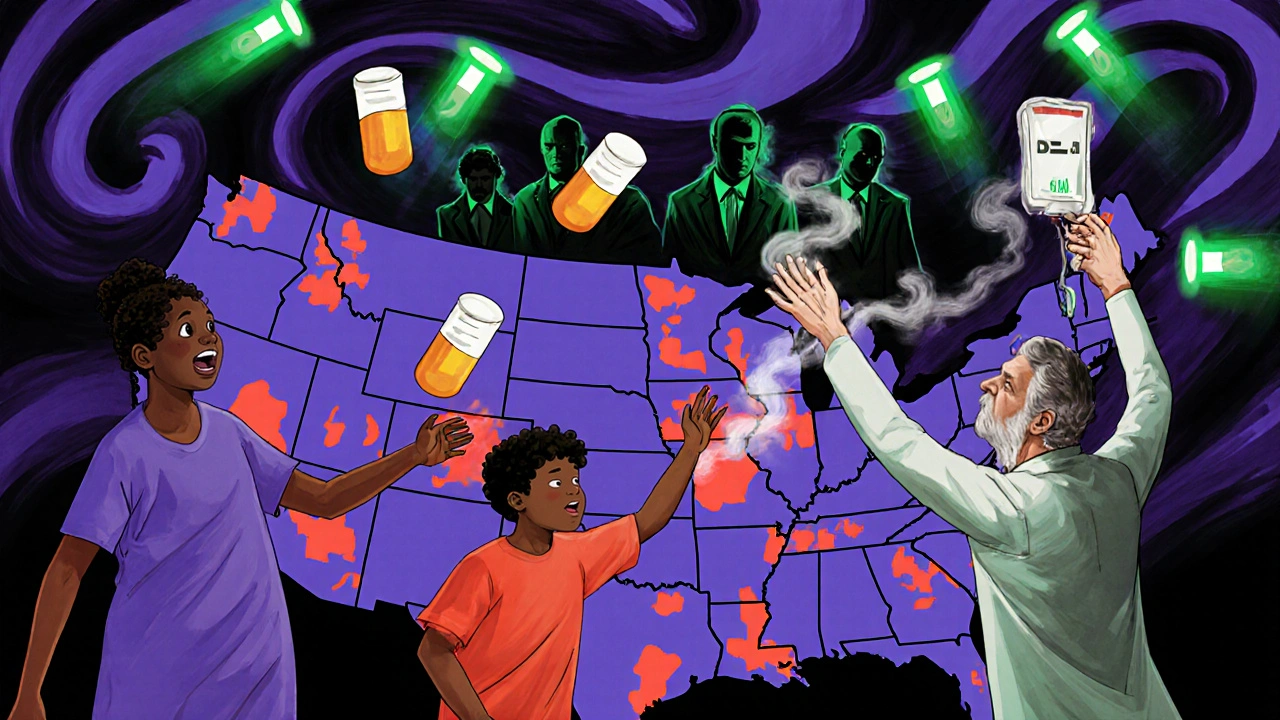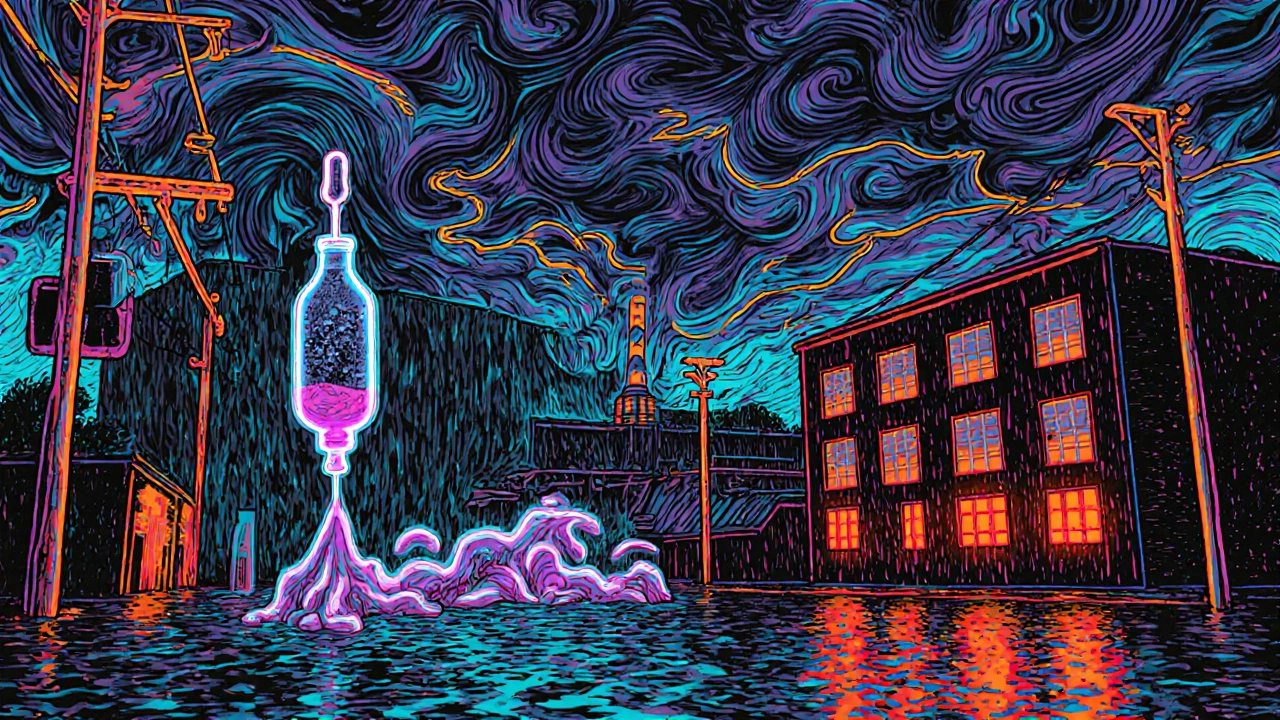When Hurricane Helene hit North Carolina in September 2024, it didn’t just knock out power and flood homes-it shut down the factory producing 60% of the U.S. supply of IV fluids. Hospitals ran out of saline bags. Emergency rooms postponed surgeries. Cancer patients waited for critical drips. This wasn’t an accident. It was a predictable failure of a system built on fragile, centralized manufacturing-and climate change is making it worse.
Why One Storm Can Break the Medicine Supply
The U.S. pharmaceutical industry doesn’t make drugs in 50 different places. It concentrates production in a handful of locations. Puerto Rico alone used to produce 10% of all FDA-approved drugs and 40% of sterile injectables like insulin and saline. After Hurricane Maria in 2017, it took 18 months for insulin supplies to recover because the power grid didn’t come back online for 11 months. Today, 65.7% of U.S. drug manufacturing facilities sit in counties that have seen at least one federally declared weather disaster between 2018 and 2023. Hurricanes are the biggest threat. They account for 47% of all climate-related drug supply disruptions, far ahead of wildfires (28%) and floods (19%). Why? Because they don’t just damage buildings-they wipe out electricity, water systems, and transportation networks. A single factory in North Cove, North Carolina, makes 1.5 million IV bags a day. When Hurricane Helene hit, that facility went dark. Within 72 hours, hospitals nationwide were rationing fluids. The FDA warned the shortage could last until mid-2025.How the System Was Built to Fail
The industry’s business model is built on efficiency, not safety. Companies run on just-in-time inventory-keeping minimal stock on hand to cut costs. That works fine in normal times. But when a disaster strikes, there’s no backup. Only 22% of sterile injectable drugs have more than two manufacturing sites in the U.S. Many have just one. This isn’t just about hurricanes. It’s about the materials that go into medicine. In Spruce Pine, North Carolina, 90% of the world’s high-purity quartz is mined. That quartz goes into the glass vials and medical devices that hold drugs. When a tornado hit Pfizer’s facility in Rocky Mount in 2023, 27 specific medicines vanished from shelves for months. Why? Because the company had no alternative supplier for the exact type of sterile packaging those drugs needed. Even small disruptions cascade. In 2022, flooding in Michigan hit Abbott’s infant formula plant during an already critical shortage. The result? The shortage lasted 8 weeks longer than it should have. One broken link in the chain-whether it’s power, packaging, or shipping-can stall everything.What Drugs Are Most at Risk
Not all drugs are equally vulnerable. The ones most likely to disappear during disasters are the old, cheap, generic ones that no one makes a lot of profit on:- Saline solution (IV fluids)
- Insulin
- Epinephrine (EpiPens)
- Propofol (used in anesthesia)
- Vancomycin (a key antibiotic)

Why Recovery Takes So Long
You can’t just flip a switch and start making drugs again after a storm. Building a new pharmaceutical facility takes 6 to 12 months. Getting specialized equipment-like sterile filling machines that cost millions-can take 2 to 3 years. Even if a company wants to rebuild, the supply chain for the supplies to rebuild with is often broken too. The FDA can approve emergency imports from overseas, but it took 28 days after Hurricane Maria to get saline from Europe. In a crisis, that’s too slow. Hospitals can’t wait a month for a life-saving drug. And when they do get the drugs, they’re often stretched thin. Pharmacy staff spend 12 to 24 hours per product just figuring out how to extend expiration dates or substitute alternatives. That’s not a technical problem-it’s a human one. Nurses and pharmacists are already overwhelmed. When disaster hits, they’re asked to do more with less.What’s Being Done-And What’s Not
Some progress is happening. The FDA launched a Critical Drug Resilience Program in January 2025 that fast-tracks approval for manufacturers who spread production across three geographically separate, climate-resilient zones. That’s a step forward. Companies like Sensos.io are using AI to predict weather impacts. They flagged Hurricane Helene’s threat to IV fluid supplies 14 days in advance. Some hospitals used that warning to stockpile extra bags. The Strategic National Stockpile is now piloting emergency reserves of injectables in hurricane zones-and saw a 40% reduction in shortage duration during Helene compared to Maria. But adoption is slow. Only 31% of major drugmakers have implemented real mitigation strategies. Sixty-eight percent now assess climate risk-but most just check a box. Only 40% of pharmaceutical industry groups have concrete plans to reduce emissions or relocate vulnerable facilities. The FDA’s proposed 2025 rule would require manufacturers of critical drugs to keep 90-day emergency inventories and submit climate risk plans. That would increase production costs by 4-7%. But experts say it could prevent 60% of climate-related shortages.
Who Gets Left Behind
Big hospitals with 500+ beds are 3.2 times more likely to map their supply chains than small clinics. That means rural hospitals, community health centers, and safety-net providers are the last to know when a drug is running out. They get the leftovers. In 2024, after BD’s blood culture vial shortage, 78% of U.S. hospitals restricted ordering. Smaller facilities couldn’t compete for the limited supply. Patients in low-income areas waited longer for infection tests. That’s not just a supply chain issue-it’s a health equity crisis.What Comes Next
Climate models predict a 25-30% increase in Category 4 and 5 hurricanes by 2030. That means more storms hitting the same vulnerable manufacturing zones. Without major changes, Duke University projects climate-related drug shortages will rise by 150% by 2030. The American Society of Clinical Oncology warns that cancer patients could face treatment delays during 8 to 10 major climate disasters every year by 2027. That’s not a hypothetical. It’s a timeline. The solution isn’t just more money. It’s a shift in thinking. We can’t treat medicine like a commodity we can order online. We need to treat it like a public utility-something we protect like clean water or electricity. That means:- Building backup factories in climate-safe regions
- Stockpiling critical drugs in multiple locations
- Fast-tracking approvals for alternative suppliers during emergencies
- Requiring manufacturers to disclose their supply chain risks
Why do natural disasters cause drug shortages?
Natural disasters damage the factories, power grids, and transportation networks that make and deliver medicines. Many critical drugs are made in just one or two U.S. facilities-often in hurricane-prone areas like Puerto Rico and North Carolina. When a storm knocks out power or floods a plant, there’s no backup. It takes months to restart production, and hospitals quickly run out of essential drugs like IV fluids, insulin, and antibiotics.
Which drugs are most likely to run out during a climate disaster?
The most vulnerable drugs are old, low-cost generics used in emergency and critical care: saline IV fluids, insulin, epinephrine, propofol, and vancomycin. These aren’t profitable for manufacturers, so they’re made in few locations with little extra stock. Cancer drugs, especially older injectables, are also at high risk because they rely on the same fragile supply chain.
How long do drug shortages last after a natural disaster?
It varies. Hurricanes typically cause 6-18 month shortages because they destroy infrastructure like power and water systems. Tornadoes may cause 3-9 month shortages focused on specific drugs from a single damaged facility. After Hurricane Maria, insulin shortages lasted 18 months. After Hurricane Helene, IV fluid shortages were projected to last until mid-2025-just 7 months after the storm.
Are there any solutions being implemented?
Yes, but slowly. The FDA now has a program to fast-track approval for drugmakers who spread production across climate-resilient regions. Some companies use AI to predict storm impacts and prepare ahead. The Strategic National Stockpile is testing emergency reserves of injectables in high-risk areas. But only 31% of major drugmakers have real mitigation plans, and most hospitals still lack the tools to respond quickly.
Why don’t drug companies just make more in different places?
Because it’s expensive. Building a new pharmaceutical facility costs hundreds of millions and takes years. Companies prioritize profit over safety-they make drugs where it’s cheapest, not safest. Generic drugs, which make up most of the shortage-prone supply, have tiny profit margins. There’s little financial incentive to invest in redundancy. Without regulation, companies won’t do it on their own.
How does this affect regular patients?
Patients face delays, substitutions, or no treatment at all. Cancer patients miss chemo doses. Diabetics can’t get insulin. Emergency rooms can’t give IV fluids to dehydrated patients. Hospitals postpone surgeries. Rural clinics get left with no supply. These aren’t abstract risks-they’re life-or-death decisions made by doctors under pressure.
Is this problem getting worse?
Yes. Climate models show a 25-30% increase in powerful hurricanes by 2030. Over two-thirds of U.S. drug factories are already in disaster-prone areas. Without major changes, experts predict climate-related shortages will rise by 150% by 2030. Cancer organizations warn patients could face treatment delays during 8-10 major climate events every year by 2027.

Eric Healy
November 18, 2025 AT 10:40Man the whole system is a joke. One storm knocks out 60% of IV fluids and we panic like it’s the end of the world? We outsource everything to save a buck then act shocked when it breaks. This ain’t rocket science. Build backups. Diversify. Stop treating life-saving meds like cheap sneakers you can just reorder next week.
Shannon Hale
November 18, 2025 AT 16:32OH MY GOD. I just read this and my blood boiled. Do you realize that saline bags are literally the difference between life and death in ERs? And the industry just shrugs? It’s not incompetence-it’s greed. They’d rather risk people dying than spend 7% more to make their supply chains resilient. This is a war on the sick. And the worst part? The people who need these drugs the most? They’re the ones getting the crumbs.
Holli Yancey
November 18, 2025 AT 21:01I’ve worked in a rural clinic for 12 years. When the IV fluid shortage hit last year, we had to ration by the mL. We’d give one bag to the dehydrated kid, then wait 48 hours for the next. No one talked about it. We just did it. The system doesn’t see us. It doesn’t see the people in towns without a hospital, just a nurse with a fridge full of expired meds. This isn’t about policy-it’s about who we decide is worth saving.
Gordon Mcdonough
November 19, 2025 AT 11:54Jessica Healey
November 19, 2025 AT 13:48My mom’s on insulin. She’s 72. Last year, when the storm hit, we had to drive 90 miles to a bigger pharmacy because the local one ran out. She cried. Not because she was scared-because she was tired. Tired of being treated like an afterthought. These aren’t luxury drugs. They’re the reason people like her wake up tomorrow. And we’re letting corporations decide who lives and who doesn’t. That’s not capitalism. That’s cruelty.
Levi Hobbs
November 19, 2025 AT 23:44I really appreciate how detailed this post is. The part about the quartz in Spruce Pine? That’s something I never even thought about. It’s not just the factories-it’s the tiny, invisible parts that make everything work. And the fact that only 22% of sterile injectables have multiple U.S. sites? That’s terrifying. I think the FDA’s new program is a start, but we need public pressure to make it stick. Maybe we should organize town halls with local reps? This isn’t just a healthcare issue-it’s a civic one.